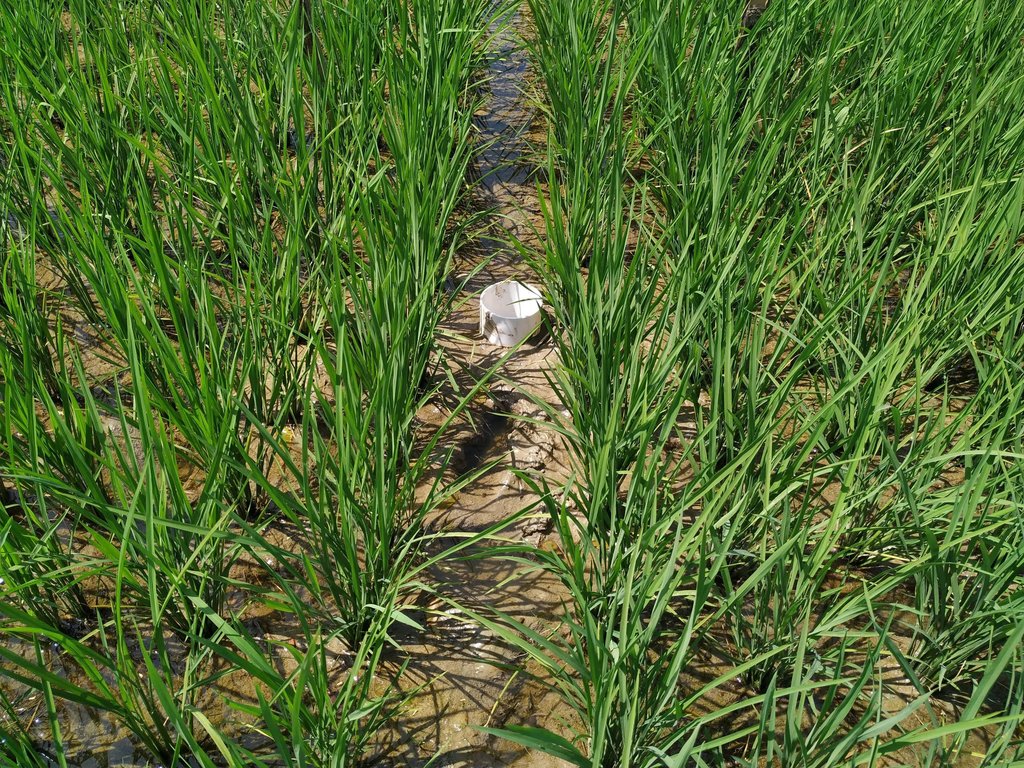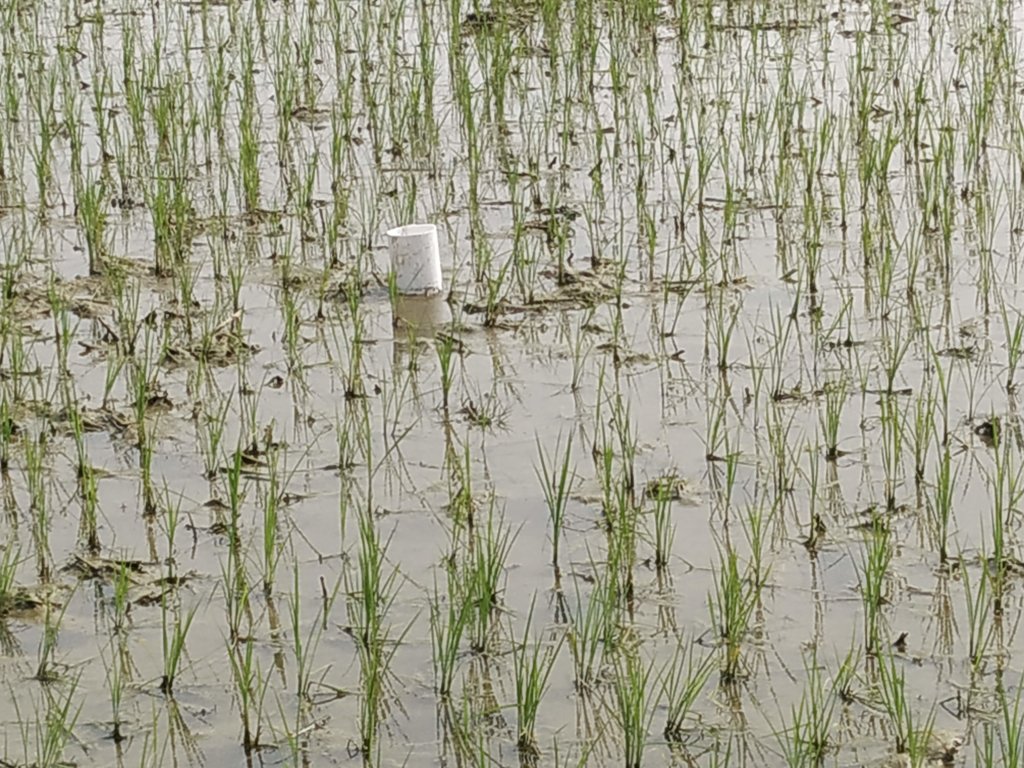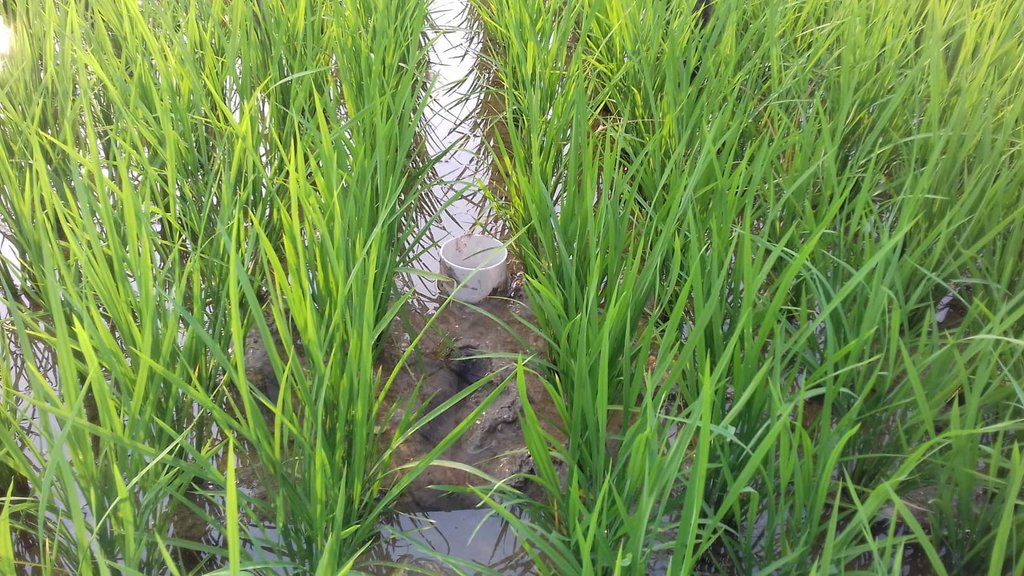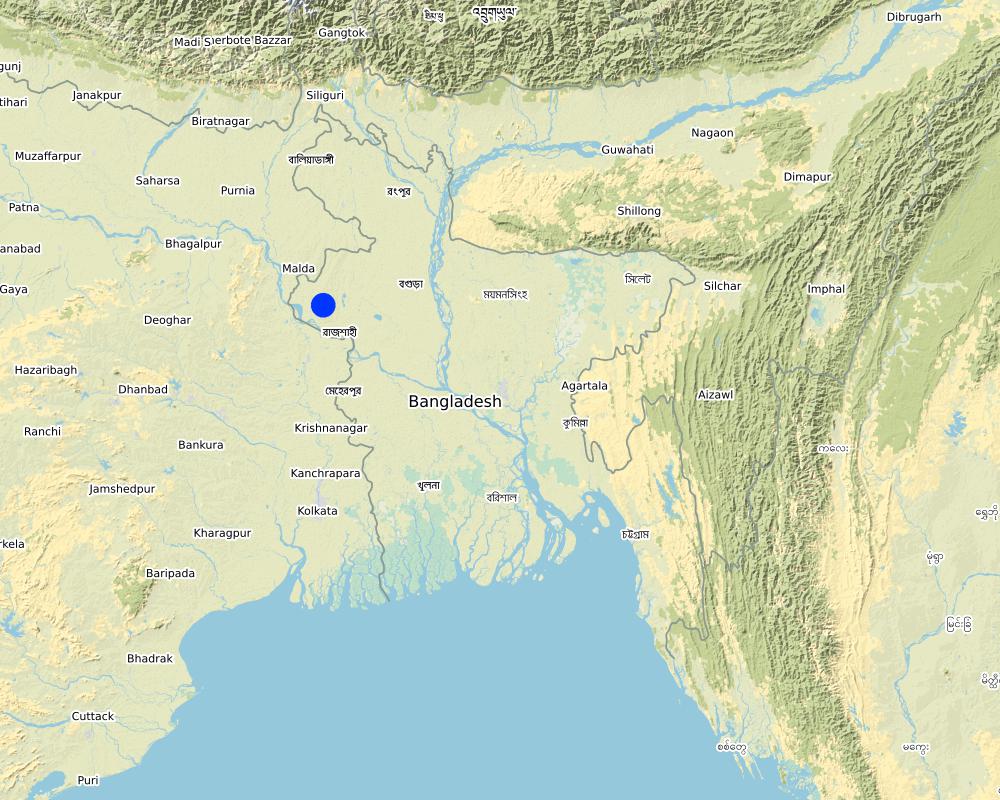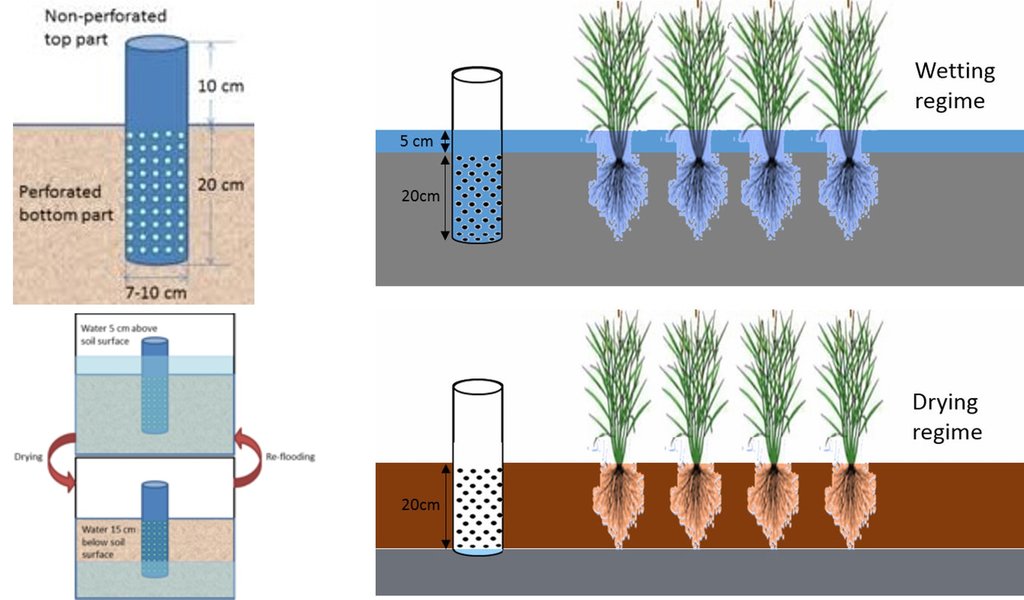Alternate wetting and drying (AWD) method in rice cultivation [บังกลาเทศ]
- ผู้สร้างสรรค์:
- การอัพเดท:
- ผู้รวบรวม: Mutasim Billah
- ผู้เรียบเรียง: Md. Monzurul Haque, Matieu Henry
- ผู้ตรวจสอบ: Nicole Harari, Rima Mekdaschi Studer, Ursula Gaemperli
Magic pipe er madhomme kom panite dhan chas
technologies_4671 - บังกลาเทศ
ดูส่วนย่อย
ขยายทั้งหมด ย่อทั้งหมด1. ข้อมูลทั่วไป
1.2 รายละเอียดที่ติดต่อได้ของผู้รวบรวมและองค์กรที่เกี่ยวข้องในการประเมินและการจัดเตรียมทำเอกสารของเทคโนโลยี
ผู้ใช้ที่ดิน:
Zaman Md. Shahid Uz
Farmer
บังกลาเทศ
co-compiler:
Azad Md. Abul Kalam
Department of Agricultural Extension (DAE)
บังกลาเทศ
co-compiler:
Jalal Uddin Dewan
Department of Agricultural Extension (DAE)
บังกลาเทศ
ชื่อของโครงการซึ่งอำนวยความสะดวกในการทำเอกสารหรือการประเมินเทคโนโลยี (ถ้าเกี่ยวข้อง)
Decision Support for Mainstreaming and Scaling out Sustainable Land Management (GEF-FAO / DS-SLM)ชื่อขององค์กรซึ่งอำนวยความสะดวกในการทำเอกสารหรือการประเมินเทคโนโลยี (ถ้าเกี่ยวข้อง)
FAO Bangladesh (FAO Bangladesh) - บังกลาเทศชื่อขององค์กรซึ่งอำนวยความสะดวกในการทำเอกสารหรือการประเมินเทคโนโลยี (ถ้าเกี่ยวข้อง)
Department of Agricultural Extension (DAE) - บังกลาเทศชื่อขององค์กรซึ่งอำนวยความสะดวกในการทำเอกสารหรือการประเมินเทคโนโลยี (ถ้าเกี่ยวข้อง)
Barind Multipurpose Development Authority (BMDA) - บังกลาเทศ1.3 เงื่อนไขการใช้ข้อมูลที่ได้บันทึกผ่านทาง WOCAT
ผู้รวบรวมและวิทยากรหลักยอมรับเงื่อนไขเกี่ยวกับการใช้ข้อมูลที่ถูกบันทึกผ่านทาง WOCAT:
ใช่
1.4 การเปิดเผยเรื่องความยั่งยืนของเทคโนโลยีที่ได้อธิบายไว้
เทคโนโลยีที่ได้อธิบายไว้นี้เป็นปัญหาของความเสื่อมโทรมโทรมของที่ดินหรือไม่ จึงไม่ได้รับการยอมรับว่าเป็นเทคโนโลยีเพื่อการจัดการที่ดินอย่างยั่งยืน:
ไม่ใช่
2. การอธิบายลักษณะของเทคโนโลยี SLM
2.1 การอธิบายแบบสั้น ๆ ของเทคโนโลยี
คำจำกัดความของเทคโนโลยี:
Alternative Drying and Wetting (AWD) is a practice in rice cultivation which decrease water use, while having no impact on rice yield. It also decreases the amount of methane into the atmosphere and fuel consumption of water pumps.
2.2 การอธิบายแบบละเอียดของเทคโนโลยี
คำอธิบาย:
The Rajshahi, Chapai Nawabganj and Naogaon regions of Bangladesh geographically belong to High Barind Tract (HBT) of Bangladesh under Agro Ecological Zone (AEZ) 26. This region is the hottest region of the country where water scarcity is a common problem. The annual precipitation is 1410 mm and the farmer is habituated to use deep tubewell underground water for their crops operated by Barind Multipurpose Development Authority (BMDA). Rice is the common crop in this region and in Boro season (from November to March) rice consumed the lion share of underground water through flood irrigation. And this flood irrigation system is very traditional cultivation method resulting the underground water table is consistently going down for heavy extraction by shallow or deep tube-well.
It is not always necessary to keep standing water in rice fields for its maximum production like aquatic plant. To address these problems ‘Alternate Wetting and Drying’ is a good choice, because it is not necessary to keep the water standing throughout the whole growing season of Boro rice (wet rice). In this method 20-25% less water is consumed, which may save approximately USD 30 per hectare.
After 10-15 days of transplanting of rice seedling shallow standing water can be allowed and then the field can be drained and wetted alternately. To implement this method, first a perforated plastic pipe is installed to examine the water level and irrigate the rice field when necessary. The 25 cm long and 7-10 cm diameter perforated pipe is installed vertically. Only the lower 15 cm of the pipe should be perforated so that water can enter and exit, and then the pipe should be installed so that the non-perforated portion remains above the ground to protect it from debris.
In a leveled rice field of one hectare, seven to eight pipes are enough to monitor water depth. 10-15 days after seedling transplanting the AWD method can start. In each irrigation, the water level should reach 5-7 cm from the above the soil in wetting regime, and when the water level goes down to the soil level in drying regime, then the field can be irrigated again. This can continue until the panicle initiation stage. Then from panicle initiation to the milking stage, the field should be irrigated with 2-4 cm of water (also wetting regime). After the milking stage, the AWD can be continued until two weeks before harvesting from April to May (depending on rice variety).
Promotion of AWD in Bangladesh has been piloted and tested by different organisations like Bangladesh Rice Research Institute (BRRI), Barind Multipurpose Development Authority (BMDA) and Department of Agricultural Extension (DAE) during 2008 to 2010. In HBT, the quantity of groundwater is continuously decreasing, so farmers applied AWD without installing the pipe. The farmers are experienced with this technology long-ago and know that the cracks appeared when the groundwater goes down to 18-20 cm below soil surface. When the farmers saw the "hair like crack" in their rice field, they irrigated. BMDA introduced the pre-paid card for irrigation, so the farmer irrigated his rice field several times when he saw the field cracks. The aim is to save money as well as to save groundwater.
2.3 รูปภาพของเทคโนโลยี
2.5 ประเทศภูมิภาค หรือสถานที่ตั้งที่เทคโนโลยีได้นำไปใช้และได้รับการครอบคลุมโดยการประเมินนี้
ประเทศ:
บังกลาเทศ
ภูมิภาค/รัฐ/จังหวัด:
Chapainawabganj
ข้อมูลจำเพาะเพิ่มเติมของสถานที่ตั้ง :
Amnura
ระบุการกระจายตัวของเทคโนโลยี:
- ใช้ ณ จุดที่เฉพาะเจาะจงหรือเน้นไปยังบริเวณพื้นที่ขนาดเล็ก
Is/are the technology site(s) located in a permanently protected area?
ไม่ใช่
แสดงความคิดเห็น:
The land user use this technology in their rice field
Map
×2.6 วันที่การดำเนินการ
ถ้าไม่รู้ปีที่แน่นอน ให้ระบุวันที่โดยประมาณ:
- น้อยกว่า 10 ปี (ไม่นานนี้)
2.7 คำแนะนำของเทคโนโลยี
ให้ระบุว่าเทคโนโลยีถูกแนะนำเข้ามาอย่างไร:
- ด้วยการริเริ่มของผู้ใช้ที่ดินเอง
- ในช่วงการทดลองหรือการทำวิจัย
- ทางโครงการหรือจากภายนอก
ความคิดเห็น (ประเภทของโครงการ เป็นต้น) :
- From long ago, farmer observed "hair like crack" in rice field that indicate water goes down in 18-20 com
- Bangladesh Rice Research Institute (BRRI) has set up a lot of research plot on AWD use
- Department of Agricultural Extension (DAE) and Barind Multipurpose Development Authority (BMDA) also has projects to install AWD in farmers field through demonstration
3. การจัดประเภทของเทคโนโลยี SLM
3.1 วัตถุประสงค์หลักของเทคโนโลยี
- ปรับปรุงการผลิตให้ดีขึ้น
- ปรับตัวเข้ากับการเปลี่ยนแปลงภูมิอากาศของโลก สภาพภูมิอากาศที่รุนแรงและผลกระทบ
- ชะลอการเปลี่ยนแปลงภูมิอากาศของโลกและผลกระทบ
3.2 ประเภทของการใช้ที่ดินในปัจจุบันที่ได้นำเทคโนโลยีไปใช้
Land use mixed within the same land unit:
ไม่ใช่

พื้นที่ปลูกพืช
- การปลูกพืชล้มลุกอายุปีเดียว
Annual cropping - Specify crops:
- cereals - rice (wetland)
จำนวนของฤดูเพาะปลูกต่อปี:
- 3
ระบุ:
Mustard/Potato/Pulse-Boro - Fallow - T.Aman
Is intercropping practiced?
ไม่ใช่
Is crop rotation practiced?
ใช่
ถ้าใช่ ระบุ:
Mustard/Potato/Pulse then irrigated Boro rice then keep fallow for few days and then again Transplanted Aman rice
3.3 Has land use changed due to the implementation of the Technology?
Has land use changed due to the implementation of the Technology?
- No (Continue with question 3.4)
3.4 การใช้น้ำ
การใช้น้ำของที่ดินที่มีการใช้เทคโนโลยีอยู่:
- น้ำฝนร่วมกับการชลประทาน
3.5 กลุ่ม SLM ที่ตรงกับเทคโนโลยีนี้
- การจัดการด้านชลประทาน (รวมถึงการลำเลียงส่งน้ำ การระบายน้ำ)
- การจัดการน้ำบาดาล
- ประสิทธิภาพด้านพลังงาน
3.6 มาตรการ SLM ที่ประกอบกันเป็นเทคโนโลยี

มาตรการอนุรักษ์ด้วยโครงสร้าง
- S7: การกักเก็บน้ำ/การส่งลำเลียง/อุปกรณ์การชลประทาน

มาตรการอนุรักษ์ด้วยการจัดการ
- M2: การเปลี่ยนแปลงของการจัดการหรือระดับความเข้มข้น
- M4: การเปลี่ยนแปลงช่วงเวลาให้เหมาะแก่การทำกิจกรรม
แสดงความคิดเห็น:
Because the cultivation technology in rice cultivation remains the same as before, except of the new irrigation regime, only S7, M2 and M4 are actually part of the measures associated with the new technology.
3.7 รูปแบบหลักของการเสื่อมโทรมของที่ดินที่ได้รับการแก้ไขโดยเทคโนโลยี

การเสื่อมโทรมของน้ำ
- Hs (Change in quantity of surface water): การเปลี่ยนแปลงปริมาณของน้ำที่ผิวดิน
- Hg (Change in groundwater): การเปลี่ยนแปลงของน้ำบาดาลหรือระดับน้ำในแอ่งน้ำบาดาล
- Hp (Decline of surface water quality): การลดลงของคุณภาพน้ำที่ผิวดิน
- Hq (Decline of groundwater quality): การลดลงของคุณภาพน้ำบาดาล

อื่น ๆ
ระบุ:
Flooding rice cultivation increase GHG emission from nitrogen fertilizer
3.8 การป้องกัน การลดลง หรือการฟื้นฟูความเสื่อมโทรมของที่ดิน
ระบุเป้าหมายของเทคโนโลยีกับความเสื่อมโทรมของที่ดิน:
- ลดความเสื่อมโทรมของดิน
4. ข้อมูลจำเพาะด้านเทคนิค กิจกรรมการนำไปปฏิบัติใช้ ปัจจัยนำเข้า และค่าใช้จ่าย
4.1 แบบแปลนทางเทคนิคของเทคโนโลยี
ข้อมูลจำเพาะด้านเทคนิค (แบบแปลนทางเทคนิคของเทคโนโลยี):
Length of plastic tube: 30 cm
Width of plastic tube: 7-10 cm
Perforated portion of plastic tube : 20 cm
Non-perforated portion of plastic tube: 10 cm
Height of irrigated water: 5 cm (above surface)
Time for irrigation: When water goes down at bottom of plastic tube (approximately 15 cm below soil surface)
Number of plastic tube: 20 in one hectare of land
ผู้เขียน:
RIAZ, A. et al. 2017.
วันที่:
06/02/2017
4.2 ข้อมูลทั่วไปเกี่ยวกับการคำนวณปัจจัยนำเข้าและค่าใช้จ่าย
ให้ระบุว่าค่าใช้จ่ายและปัจจัยนำเข้าได้รับการคำนวณอย่างไร:
- ต่อพื้นที่ที่ใช้เทคโนโลยี
ระบุขนาดและหน่วยพื้นที่:
1 Hectare
ระบุสกุลเงินที่ใช้คำนวณค่าใช้จ่าย:
- USD
ระบุค่าเฉลี่ยของค่าจ้างในการจ้างแรงงานต่อวัน:
USD 5.0
4.3 กิจกรรมเพื่อการจัดตั้ง
| กิจกรรม | Timing (season) | |
|---|---|---|
| 1. | Plastic tube installation | March - April |
4.4 ค่าใช้จ่ายของปัจจัยนำเข้าที่จำเป็นสำหรับการจัดตั้ง
| ปัจจัยนำเข้า | หน่วย | ปริมาณ | ค่าใช้จ่ายต่อหน่วย | ค่าใช้จ่ายทั้งหมดต่อปัจจัยนำเข้า | %ของค่าใช้จ่ายที่ก่อให้เกิดขึ้นโดยผู้ใช้ที่ดิน | |
|---|---|---|---|---|---|---|
| แรงงาน | Labour for plastic tube installation | Person-day | 1.0 | 5.0 | 5.0 | 100.0 |
| อุปกรณ์ | Plastic tube | Number | 20.0 | 0.64 | 12.8 | 100.0 |
| ค่าใช้จ่ายทั้งหมดของการจัดตั้งเทคโนโลยี | 17.8 | |||||
| Total costs for establishment of the Technology in USD | 17.8 | |||||
4.5 การบำรุงรักษาสภาพหรือกิจกรรมที่เกิดขึ้นเป็นประจำ
| กิจกรรม | ช่วงระยะเวลา/ความถี่ | |
|---|---|---|
| 1. | Land preparation (cleaning land, repairing border, repairing canal etc. manual work) | January - February |
| 2. | Plowing | January - February |
| 3. | Seedling transplanting | January - February |
| 4. | Irrigation in different vegetative and reproductive stages | January - May |
| 5. | Fertilization | January - April |
| 6. | Herbicide and pesticide application | January - March |
| 7. | Harvesting | May - June |
| 8. | Threshing | May - June |
4.6 ค่าใช้จ่ายของปัจจัยนำเข้าและกิจกรรมที่เกิดขึ้นเป็นประจำที่ต้องการการบำรุงรักษา (ต่อปี)
| ปัจจัยนำเข้า | หน่วย | ปริมาณ | ค่าใช้จ่ายต่อหน่วย | ค่าใช้จ่ายทั้งหมดต่อปัจจัยนำเข้า | %ของค่าใช้จ่ายที่ก่อให้เกิดขึ้นโดยผู้ใช้ที่ดิน | |
|---|---|---|---|---|---|---|
| แรงงาน | Land preparation | Person-day | 6.0 | 5.0 | 30.0 | 100.0 |
| แรงงาน | Seedling transplanting | Person-day | 37.0 | 5.0 | 185.0 | 100.0 |
| แรงงาน | Herbicide and pesticide application | Person-day | 8.0 | 5.0 | 40.0 | 100.0 |
| แรงงาน | Irrigation | Person-day | 18.0 | 5.0 | 90.0 | 100.0 |
| อุปกรณ์ | Power tiller rent for plowing | Machine-hour | 16.0 | 2.0 | 32.0 | 100.0 |
| อุปกรณ์ | Sprayer | Machine-hour | 24.0 | 1.0 | 24.0 | 100.0 |
| อุปกรณ์ | Cost for irrigation | Machine-hour | 22.0 | 2.5 | 55.0 | 100.0 |
| วัสดุด้านพืช | Seed | kg | 15.0 | 1.3 | 19.5 | 100.0 |
| ปุ๋ยและสารฆ่า/ยับยั้งการเจริญเติบโตของสิ่งมีชีวิต (ไบโอไซด์) | Chemical fertilizer | Kg | 70.0 | 0.35 | 24.5 | 100.0 |
| ปุ๋ยและสารฆ่า/ยับยั้งการเจริญเติบโตของสิ่งมีชีวิต (ไบโอไซด์) | Manure | Kg | 1500.0 | 0.05 | 75.0 | 100.0 |
| ปุ๋ยและสารฆ่า/ยับยั้งการเจริญเติบโตของสิ่งมีชีวิต (ไบโอไซด์) | Herbicide and pesticide | Kg | 18.0 | 2.4 | 43.2 | 100.0 |
| อื่น ๆ | Labour for harvesting | Person-day | 24.0 | 5.0 | 120.0 | 100.0 |
| อื่น ๆ | Labour for threshing | Person-day | 10.0 | 5.0 | 50.0 | 100.0 |
| อื่น ๆ | Labour for drying | Person-day | 4.0 | 5.0 | 20.0 | 100.0 |
| อื่น ๆ | Labour for repairing spray machine | Person-day | 2.0 | 5.0 | 10.0 | 100.0 |
| อื่น ๆ | Labour for cleaning plastic tube | Person-day | 1.0 | 5.0 | 5.0 | 100.0 |
| ค่าใช้จ่ายทั้งหมดของการบำรุงรักษาสภาพเทคโนโลยี | 823.2 | |||||
| Total costs for maintenance of the Technology in USD | 823.2 | |||||
แสดงความคิดเห็น:
For the sake of completeness, all recurring costs relating to rice growing have been listed here. However, the recurring costs for AWD technology are actually only those related to irrigation (work for irrigation, patching and cleaning). Irrigation pump installation and maintenance cost belongs to BMDA, the farmer have no responsibility on irrigation pump. They just purchase irrigation water through pre-paid card.
4.7 ปัจจัยสำคัญที่สุดที่มีผลกระทบต่อค่าใช้จ่าย
ปัจจัยสำคัญที่สุดที่มีผลกระทบต่อค่าใช้จ่ายต่างๆ:
- Irrigation according to wetting and drying regimes
5. สิ่งแวดล้อมทางธรรมชาติและของมนุษย์
5.1 ภูมิอากาศ
ฝนประจำปี
- < 250 ม.ม.
- 251-500 ม.ม.
- 501-750 ม.ม.
- 751-1,000 ม.ม.
- 1,001-1,500 ม.ม.
- 1,501-2,000 ม.ม.
- 2,001-3,000 ม.ม.
- 3,001-4,000 ม.ม.
- > 4,000 ม.ม.
ระบุปริมาณน้ำฝนเฉลี่ยรายปี (ถ้ารู้) :หน่วย ม.ม.
1400.00
ข้อมูลจำเพาะ/ความคิดเห็นเรื่องปริมาณน้ำฝน:
The average rainfall in High Barind Tract is low than other parts of Bangladesh
ระบุชื่อของสถานีตรวดวัดอากาศที่ใช้อ้างอิงคือ:
Weather Atlas; {https://www.weather-atlas.com/en/bangladesh/rajshahi-climate#rainfall}
เขตภูมิอากาศเกษตร
- กึ่งชุ่มชื้น
5.2 สภาพภูมิประเทศ
ค่าเฉลี่ยความลาดชัน:
- ราบเรียบ (0-2%)
- ลาดที่ไม่ชัน (3-5%)
- ปานกลาง (6-10%)
- เป็นลูกคลื่น (11-15%)
- เป็นเนิน (16-30%)
- ชัน (31-60%)
- ชันมาก (>60%)
ธรณีสัณฐาน:
- ที่ราบสูง/ที่ราบ
- สันเขา
- ไหล่เขา
- ไหล่เนินเขา
- ตีนเนิน
- หุบเขา
ระดับความสูง:
- 0-100 เมตร
- 101-500 เมตร
- 501-1,000 เมตร
- 1,001-1,500 เมตร
- 1,501-2,000 เมตร
- 2,001-2,500 เมตร
- 2,501-3,000 เมตร
- 3,001-4,000 เมตร
- > 4,000 เมตร
ให้ระบุถ้าเทคโนโลยีได้ถูกนำไปใช้:
- บริเวณสันเขา (convex situations)
5.3 ดิน
ค่าเฉลี่ยความลึกของดิน:
- ตื้นมาก (0-20 ซ.ม.)
- ตื้น (21-50 ซ.ม.)
- ลึกปานกลาง (51-80 ซ.ม.)
- ลึก (81-120 ซ.ม.)
- ลึกมาก (>120 ซ.ม.)
เนื้อดิน (ดินชั้นบน):
- ละเอียด/หนัก (ดินเหนียว)
เนื้อดินล่าง (> 20 ซ.ม.ต่ำจากผิวดิน):
- ละเอียด/หนัก (ดินเหนียว)
อินทรียวัตถุในดิน:
- ต่ำ (<1%)
5.4 ความเป็นประโยชน์และคุณภาพของน้ำ
ระดับน้ำใต้ดิน:
5-50 เมตร
น้ำไหลบ่าที่ผิวดิน:
ไม่ดีหรือไม่มีเลย
คุณภาพน้ำ (ที่ยังไม่ได้บำบัด):
เป็นน้ำเพื่อการดื่มที่ดี
Water quality refers to:
ground water
ความเค็มของน้ำเป็นปัญหาหรือไม่:
ไม่ใช่
กำลังเกิดน้ำท่วมในพื้นที่หรือไม่:
ไม่ใช่
5.5 ความหลากหลายทางชีวภาพ
ความหลากหลายทางชนิดพันธุ์:
- ต่ำ
ความหลากหลายของแหล่งที่อยู่:
- ต่ำ
5.6 ลักษณะของผู้ใช้ที่ดินที่นำเทคโนโลยีไปปฏิบัติใช้
อยู่กับที่หรือเร่ร่อน:
- อยู่กับที่
แนวทางการตลาดของระบบการผลิต:
- เพื่อการยังชีพ (หาเลี้ยงตนเอง)
- mixed (subsistence/ commercial)
รายได้ที่มาจากนอกฟาร์ม:
- < 10% ของรายได้ทั้งหมด
ระดับของความมั่งคั่งโดยเปรียบเทียบ:
- ยากจนมาก
- จน
เป็นรายบุคคล/ครัวเรือน:
- เป็นรายบุคคล/ครัวเรือน
ระดับของการใช้เครื่องจักรกล:
- งานที่ใช้แรงกาย
- การใช้กำลังจากสัตว์
เพศ:
- หญิง
- ชาย
อายุของผู้ใช้ที่ดิน:
- ผู้เยาว์
- วัยกลางคน
- ผู้สูงอายุ
5.7 Average area of land used by land users applying the Technology
- < 0.5 เฮกตาร์
- 0.5-1 เฮกตาร์
- 1-2 เฮกตาร์
- 2-5 เฮกตาร์
- 5-15 เฮกตาร์
- 15-50 เฮกตาร์
- 50-100 เฮกตาร์
- 100-500 เฮกตาร์
- 500-1,000 เฮกตาร์
- 1,000-10,000 เฮกตาร์
- >10,000 เฮกตาร์
พิจารณาว่าเป็นขนาดเล็ก กลาง หรือขนาดใหญ่ (ซึ่งอ้างอิงถึงบริบทระดับท้องถิ่น):
- ขนาดเล็ก
5.8 กรรมสิทธิ์ในที่ดิน สิทธิในการใช้ที่ดินและสิทธิในการใช้น้ำ
กรรมสิทธิ์ในที่ดิน:
- รายบุคคล ได้รับสิทธิครอบครอง
สิทธิในการใช้ที่ดิน:
- เช่า
- รายบุคคล
สิทธิในการใช้น้ำ:
- รายบุคคล
Are land use rights based on a traditional legal system?
ใช่
ระบุ:
In Chapai Nawabganj, there are two types of land viz. Government owned and (popularly known as Khas land) and public owned land. The public owned land has registered to a person and that person paid tax to Government in yearly basis, this is the way of traditional legal system.
5.9 การเข้าถึงบริการและโครงสร้างพื้นฐาน
สุขภาพ:
- จน
- ปานกลาง
- ดี
การศึกษา:
- จน
- ปานกลาง
- ดี
ความช่วยเหลือทางด้านเทคนิค:
- จน
- ปานกลาง
- ดี
การจ้างงาน (เช่น ภายนอกฟาร์ม):
- จน
- ปานกลาง
- ดี
ตลาด:
- จน
- ปานกลาง
- ดี
พลังงาน:
- จน
- ปานกลาง
- ดี
ถนนและการขนส่ง:
- จน
- ปานกลาง
- ดี
น้ำดื่มและการสุขาภิบาล:
- จน
- ปานกลาง
- ดี
บริการด้านการเงิน:
- จน
- ปานกลาง
- ดี
6. ผลกระทบและสรุปคำบอกกล่าว
6.1 ผลกระทบในพื้นที่ดำเนินการ (On-site) จากการใช้เทคโนโลยี
ผลกระทบทางด้านเศรษฐกิจและสังคม
การผลิต
การผลิตพืชผล
แสดงความคิดเห็น/ระบุ:
AWD increases the crop production (yield) than traditional method. So, more crop yield increases the socio-economic condition of farmer. Moreover, this method reduces the input cost for crop production.
การเสี่ยงต่อความล้มเหลวในการผลิต
พื้นที่สำหรับการผลิต
แสดงความคิดเห็น/ระบุ:
AWD method decreases the production cost for irrigation. So, the land area under this method is increasing gradually.
การจัดการที่ดิน
ความเป็นประโยชน์และคุณภาพของน้ำ
การมีน้ำดื่มไว้ให้ใช้
แสดงความคิดเห็น/ระบุ:
The irrigation water and the drinking water come from same underground source by deep tube-well. So, when the water extraction is reduce for irrigation, the availability for drinking water is increase.
การมีน้ำไว้ให้สำหรับการชลประทาน
ความต้องการน้ำจากการชลประทาน
รายได้และค่าใช้จ่าย
ค่าใช่จ่ายของปัจจัยการผลิตทางการเกษตร
รายได้จากฟาร์ม
ภาระงาน
ผลกระทบด้านสังคมวัฒนธรรมอื่น ๆ
ความมั่นคงด้านอาหาร / พึ่งตนเองได้
SLM หรือความรู้เรื่องความเสื่อมโทรมของที่ดิน
ผลกระทบด้านนิเวศวิทยา
วัฐจักรน้ำหรือน้ำบ่า
ปริมาณน้ำ
การเก็บเกี่ยวหรือการกักเก็บน้ำ
การระบายน้ำส่วนเกิน
น้ำบาดาลหรือระดับน้ำในแอ่งน้ำบาดาล
การระเหย
แสดงความคิดเห็น/ระบุ:
In dry regime of AWD method, the evaporation is decrease on land
ดิน
การหมุนเวียนและการเติมของธาตุอาหาร
แสดงความคิดเห็น/ระบุ:
Some plant nutrient like Zinc (Zn) is much available when the soil going from wet to dry regime. Constant wet condition inhibit some other plant nutrient also.
อินทรียวัตถุในดิน/ต่ำกว่าดินชั้น C
ความหลากหลายทางชีวภาพของพืชและสัตว์
มวลชีวภาพ/เหนือดินชั้น C
การจัดการศัตรูพืชและโรคพืช
ลดความเสี่ยงของภัยพิบัติ
ผลกระทบจากภัยแล้ง
การปล่อยคาร์บอนและก๊าซเรือนกระจก
ภูมิอากาศจุลภาค
6.2 ผลกระทบนอกพื้นที่ดำเนินการ (Off-site) จากการใช้เทคโนโลยี
น้ำที่ใช้ประโยชน์ได้
ผลกระทบของก๊าซเรือนกระจก
6.3 การเผชิญและความตอบสนองของเทคโนโลยีต่อการเปลี่ยนแปลงสภาพภูมิอากาศที่ค่อยเป็นค่อยไป และสภาพรุนแรงของภูมิอากาศ / ภัยพิบัติ (ที่รับรู้ได้โดยผู้ใช้ที่ดิน)
การเปลี่ยนแปลงสภาพภูมิอากาศที่ค่อยเป็นค่อยไป
การเปลี่ยนแปลงสภาพภูมิอากาศที่ค่อยเป็นค่อยไป
| ฤดู | increase or decrease | เทคโนโลยีมีวิธีการรับมืออย่างไร | |
|---|---|---|---|
| อุณหภูมิประจำปี | เพิ่มขึ้น | ดี | |
| อุณหภูมิตามฤดูกาล | ฤดูแล้ง | เพิ่มขึ้น | ดี |
| ฝนประจำปี | ลดลง | ดี | |
| ฝนตามฤดู | ฤดูร้อน | ลดลง | ดี |
สภาพรุนแรงของภูมิอากาศ (ภัยพิบัติ)
ภัยพิบัติทางอุตุนิยมวิทยา
| เทคโนโลยีมีวิธีการรับมืออย่างไร | |
|---|---|
| พายุทอร์นาโดประจำท้องถิ่น | ปานกลาง |
ภัยพิบัติจากสภาพภูมิอากาศ
| เทคโนโลยีมีวิธีการรับมืออย่างไร | |
|---|---|
| ภัยจากฝนแล้ง | ดีมาก |
6.4 การวิเคราะห์ค่าใช้จ่ายและผลประโยชน์ที่ได้รับ
ผลประโยชน์ที่ได้รับเปรียบเทียบกับค่าใช้จ่ายในการจัดตั้งเป็นอย่างไร (จากมุมมองของผู้ใช้ที่ดิน)
ผลตอบแทนระยะสั้น:
ด้านบวก
ผลตอบแทนระยะยาว:
ด้านบวก
ผลประโยชน์ที่ได้รับเปรียบเทียบกับค่าใช้จ่ายในการบำรุงรักษาหรือต้นทุนที่เกิดขึ้นซ้ำอีก เป็นอย่างไร (จากมุมมองของผู้ใช้ที่ดิน)
ผลตอบแทนระยะสั้น:
ด้านบวกอย่างมาก
ผลตอบแทนระยะยาว:
ด้านบวกอย่างมาก
6.5 การปรับตัวของเทคโนโลยี
- 11-50%
Of all those who have adopted the Technology, how many did so spontaneously, i.e. without receiving any material incentives/ payments?
- 91-100%
6.6 การปรับตัว
เทคโนโลยีได้รับการปรับเปลี่ยนเมื่อเร็วๆนี้ เพื่อให้ปรับตัวเข้ากับสภาพที่กำลังเปลี่ยนแปลงหรือไม่:
ไม่ใช่
6.7 จุดแข็ง / ข้อได้เปรียบ / โอกาสของเทคโนโลยี
| จุดแข็ง / ข้อได้เปรียบ / โอกาสในทัศนคติของผู้ใช้ที่ดิน |
|---|
| Easy to monitor irrigation schedule in AWD method. Farmer able to understand about dry and wet regime of rice cultivation that reduce the irrigation cost. |
| This Alternate Wetting and Drying (AWD) system enhance the tillering of rice resulting yield would be higher than traditional continuous flooding cultivation system |
| จุดแข็ง / ข้อได้เปรียบ / โอกาสในทัศนคติของผู้รวบรวมหรือวิทยากรหลัก |
|---|
| AWD facilitate drying rice field for certain period. This practice inhibit the chemical reaction of nitrogen fertilizer that emit low greenhouse gas |
| Water is the most demandable input and in AWD system the requirement of irrigation water become low that reduces input cost |
| Potentials for scale-up of this AWD method, because the groundwater scarcity became increase that would be popular to all farmer |
6.8 จุดอ่อน / ข้อเสียเปรียบ / ความเสี่ยงของเทคโนโลยีและวิธีการแก้ไข
| จุดอ่อน / ข้อเสียเปรียบ / ความเสี่ยงในทัศนคติของผู้ใช้ที่ดิน | มีวิธีการแก้ไขได้อย่างไร |
|---|---|
| Magic pipe is not available everywhere | Department of Agricultural Extension (DAE) support them to use AWD |
| Technical knowledge | Sub-Assistant Agriculture Officer (SAAO) and resource farmer provide technical support |
| จุดอ่อน / ข้อเสียเปรียบ / ความเสี่ยงในทัศนคติของผู้รวบรวมหรือวิทยากรหลัก | มีวิธีการแก้ไขได้อย่างไร |
|---|---|
| Technical knowledge of land user | Consultation with SAAO and resource farmer |
| Misunderstanding on yield to use AWD; Land user think yield is lower when using Alternative Wetting and Drying method | Show results by taking farmers to visit demonstration plots, field day, cross visit etc. |
7. การอ้างอิงและการเชื่อมต่อ
7.1 วิธีการและแหล่งข้อมูล
- ไปเยี่ยมชมภาคสนาม การสำรวจพื้นที่ภาคสนาม
3
- การสัมภาษณ์กับผู้ใช้ที่ดิน
4
- การสัมภาษณ์ผู้เชี่ยวชาญด้าน SLM หรือผู้ชำนาญ
3
วันที่เก็บรวบรวมข้อมูล(ภาคสนาม) :
14/02/2019
7.2 การอ้างอิงถึงสิ่งตีพิมพ์
หัวข้อ, ผู้เขียน, ปี, หมายเลข ISBN:
Bangladesh Rice Research institute (BRRI), Gazipur
ชื่อเรื่อง ผู้เขียน ปี ISBN:
Internet, free
7.3 Links to relevant online information
ชื่อเรื่องหรือคำอธิบาย:
Use of irrigation water saving technology (AWD) in rice field
URL:
http://www.knowledgebank-brri.org/Rice_Production_Training_Manual/Day_2/Module_7/Factsheet%204%20-%20water%20saving%20technology%20(AWD).pdf
7.4 General comments
In the case of annual crop cultivation, the questionnaire should be revised.
ลิงก์และโมดูล
ขยายทั้งหมด ย่อทั้งหมดลิงก์
ไม่มีลิงก์
โมดูล
ไม่มีโมดูล



